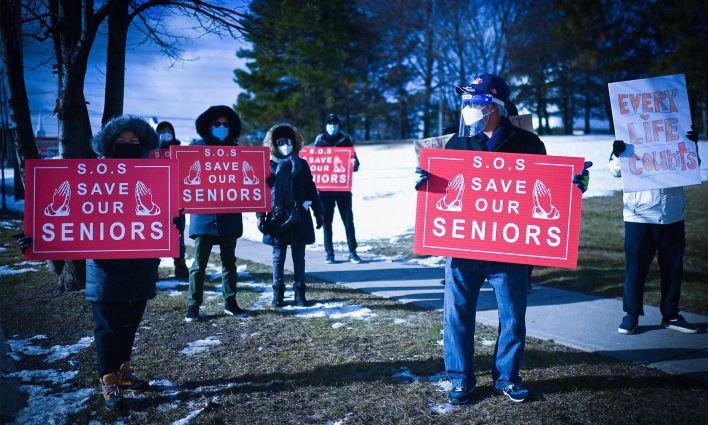This trend has been associated with gentrification and rising rents, displacement and eviction, and negative tenant experiences. In the interests of housing justice we need policies to protect tenants, guarantee affordability and de-financialize housing.
Over 40 per cent of Canadian tenants pay more than they can afford for housing. In Canada’s largest cities, rents increased by an average of 20 per cent between 2014 and 2019, such that full-time minimum wage workers could find affordable rents in only three of the country’s neighborhoods. While the media heralded falling rents during the pandemic, rents continued to rise. Rising inflation that began in 2021 is only making things worse, driving even faster-paced rent increases.
A nation of landlords
Canada is traditionally painted as a nation of homeowners, with two-thirds of households owning their homes. One in five of those homeowners is also a landlord (owning multiple properties), meaning that they profit from high rents.
While the landscape of rental housing has long included small-scale landlords and bigger corporate firms, since the 1990s a new type of firm entered the fray: the financial landlord. These are financial firms that acquire rental housing properties and manage them as investment products, allowing investors to profit from multi-family housing.
Financial landlords include publicly traded firms, private equity, institutions (banks, insurance agencies, pension funds), real estate investment trusts (REITs), and other vehicles that buy and manage real estate for investors. In the past 25 years, financial landlords have dramatically expanded their ownership of rental buildings.
REITs alone rose from owning zero rental suites in 1996, to over 200,000 in 2021. The biggest 25 financial firms together held 340,000 suites in 2021—about 20 per cent of Canada’s purpose-built multi-family stock. Some industry experts estimate that 30 per cent of apartments are financialized.
The profit-making strategies of financial landlords
While all private landlords are driven by the profit motive, financial firms are bound to the objectives of shareholders and executives, and their management operates with a fiduciary responsibility to prioritize profit-making above other goals. Investors may expect a certain level of return, and executives may suffer financially if share value falls. As a result, financial firms often engage in aggressive property management strategies to drive higher revenues and reduce expenses.
These strategies raise rents and fees, cut maintenance and superintendent costs, and catalyze gentrification and displacement.
Firms use a few different strategies to “reposition” buildings to be more profitable, or to “add value,” in the language of investors. Value can be added by reducing expenses—investing in energy efficiency upgrades and capitalizing on economies of scale (bulk purchasing, harmonizing property management, etc.), but also by cutting costs on maintenance and superintendents, which can worsen tenant quality of life.
Firms also squeeze out more profit by raising revenues—charging new fees (such as ancillary fees and sub-metering utilities) and by increasing rents. Financial firms raise rents by systematically enforcing annual allowable increases, by applying for “above guideline increases” (AGIs) at high rates, and by capitalizing on “vacancy decontrol” policies that allow for increases of any amount when a unit becomes vacant.
Financialized gentrification occurs in areas where firms reposition affordable units into higher-end suites in coveted market locations, where sharp increases in rents can be applied by hastening the removal of existing tenants and renovating vacant units. A senior executive with Hazelview Investments, an asset manager with over 21,000 suites, described this strategy: “Large cities in Canada are currently experiencing a wave of gentrification,” which “is creating a number of compelling opportunities for REITs to experience outsized growth and offer increasing value for investors.”
A more recent strategy deployed by financial firms is to intensify development on their owned lands—often large sites with apartments built in the 1960s–1970s and surrounded by greenspace or parking.
Intensification generates new profitable assets either by way of new-build developments or by demolishing existing rental stock and redeveloping the already-built environment, an approach used by firms like Hazelview and discussed further below.
These strategies are not only used by financial firms, but are being adopted by other big corporate landlords, property management firms and small-scale “mom-and-pop” landlords as well.
Why does this matter?
The strategies that enrich investors succeed at the expense of tenants, who pay in many ways. Tenants are negatively affected by firms that cut costs and maintenance, and experience economic hardship through rising rents and fees. Tenants experience stress and anxiety as they live through so-called repositioning. Tenants are harmed by eviction and displacement, which can disconnect them from their homes and communities of support.
Financialized gentrification intensifies patterns of social and spatial inequality in our cities, reinforcing the exclusion of lower-income renters from parts of town that are often well-serviced by transit, retail and other amenities. Across the country, this trend is associated with the loss of affordable housing. Indeed, researchers Steve Pomeroy and Duncan McLennan have calculated that 322,600 affordable rental units were lost between 2011–2016, as financial firms snap them up and raise prices. These losses far exceed what is being built through government programs.
Given that low-income, racially marginalized, disabled, Indigenous, and immigrant households rent at high rates, the negative consequences of rental housing financialization are likely to disproportionately impact the “priority groups” identified by Canada’s National Housing Strategy.
In Ottawa’s Herongate community, a human rights case (Yussuf et al. v. Timbercreek, 2019) has been launched alleging that “the mass, forced displacement of an entire community of immigrants, people of colour, families, and people receiving public assistance amounts to systemic discrimination.” Asserting that the Herongate mass eviction violated human rights law, the application asks the Ontario Human Rights Tribunal to determine whether a landlord has the right to displace and replace a lower-income racialized community with an affluent white community.
What can we do about it?
Governments at all levels have played a role in enabling the financialization of rental housing and catalyzing Canada’s affordable housing crisis. Financial firms emerged to capitalize on rental housing in the late 1990s, just as the federal government had abdicated responsibility for producing and maintaining affordable rental housing, and as the deregulation of tenant protections and rent controls opened the door to new profit-making strategies. Despite the launch of a National Housing Strategy in 2017, affordability has gotten worse rather than better.
There is much, however, that governments can do. According to Leilani Farha, director of The Shift and former United Nations Special Rapporteur on Adequate Housing, governments at all levels have an obligation to progressively realize the right to housing. To really make a difference, governments must immediately stop the loss of affordable housing. They can do this by introducing strong rent controls and eliminating loopholes (like AGIs and vacancy decontrol) that cannibalize affordability.
The federal and provincial governments should fund programs to acquire existing rental housing and make it permanently affordable—stemming the loss to financial landlords. New social and affordable housing should be built to meet the high and growing demand for it. Investors (including pension fund contributors) should divest from real estate firms that profit from displacement, and governments and lenders should discontinue support to firms that violate the right to adequate housing, including financial firms.
At the same time, tenant organizing in Ontario cities and beyond has to date represented the most significant challenge to the financialization of rental housing. Tenant organizing has challenged landlord neglect, rent increases and evictions. In Herongate, fierce tenant resistance prompted Hazelview to pivot and adopt a "social framework” that commits to no further displacement.
While inherently problematic—in that the Herongate redevelopment proposal, which was approved by the City of Ottawa in late 2021, targets over 550 more existing affordable units for demolition—this example demonstrates that in the absence of government protection (and the presence of government complicity), grassroots tenant organizing can have an impact. Likewise, the outcome of the Herongate human rights case may set a precedent in stemming the tide of financialized gentrification targeting racialized communities.







